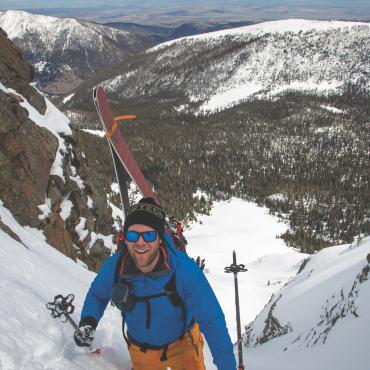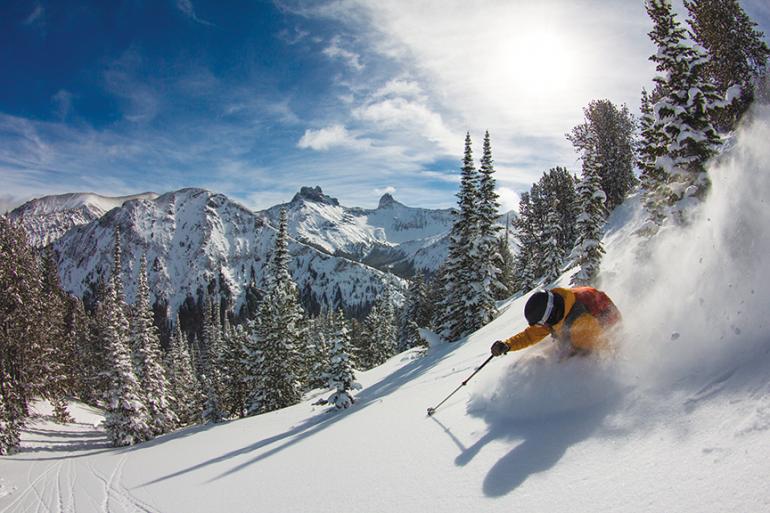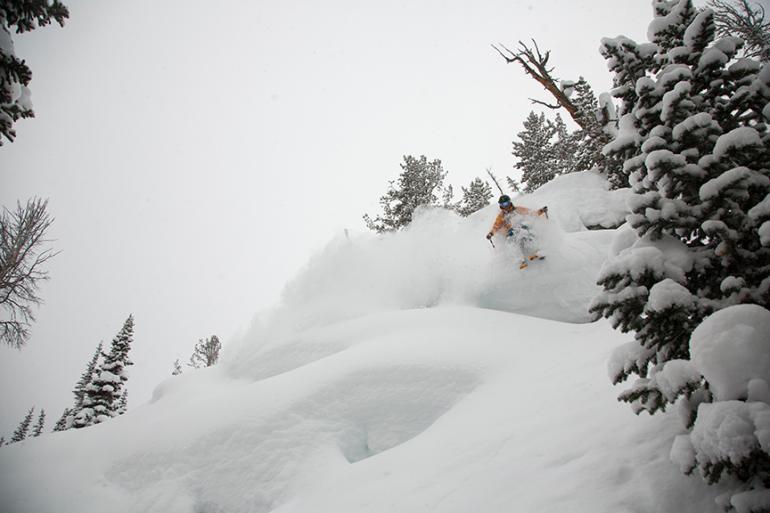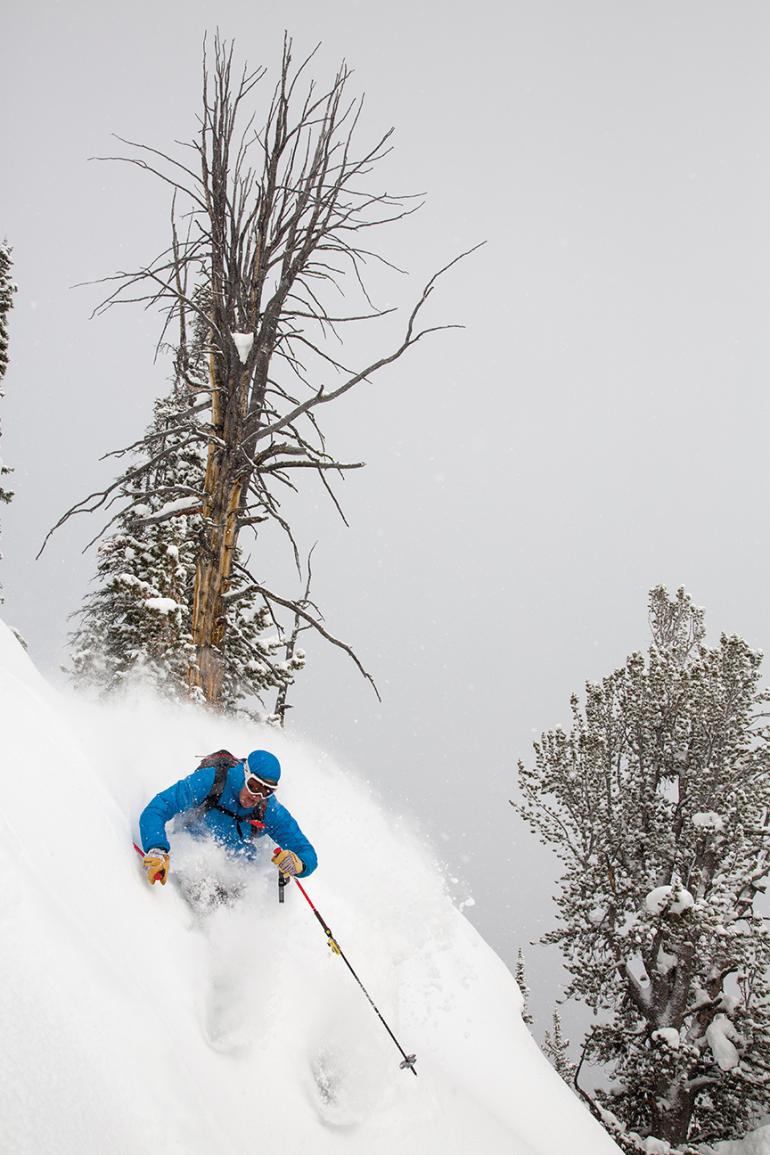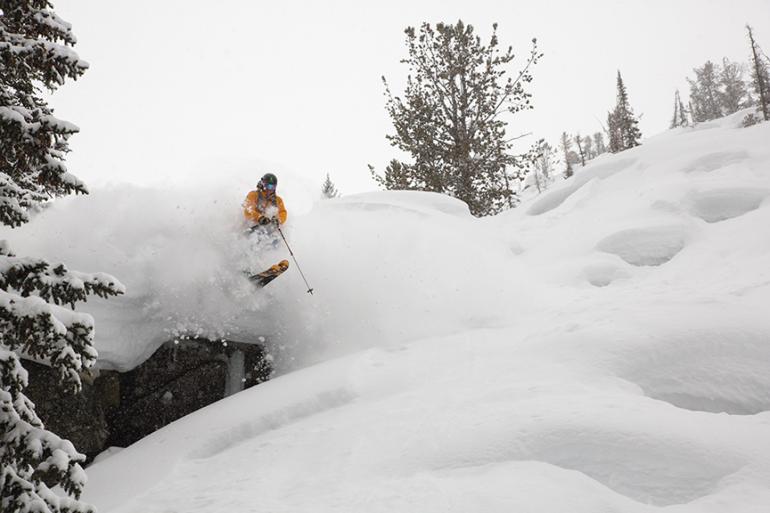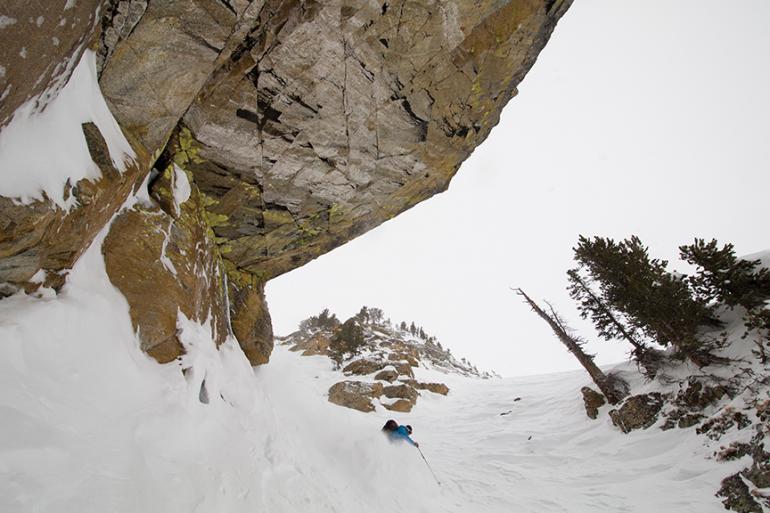Powder to the People
At the crest of Woody Ridge, the wind is howling. It’s the kind of wind that shears through Gore-Tex like muslin and isolates people behind their hoods and goggles. Even if we wanted to talk, our words would be spirited away before leaving our lips. But when we drop onto the west side of the ridge a few minutes later, above a series of chutes streaking through the whitebark pine forest like white-tailed comets, the wind ceases. Here, the snow is undisturbed and the air is still, though I can still hear it whistling just overhead.
“Take your pick,” Ben says as he lowers his hood and rips the skins from his skis. We’re staring down three indistinguishably perfect alleyways, each choked with powder, pitching away at a relaxed 30 degrees. “There’s not a bad line in the bunch,” he continues. “Hell, let’s ski them all.” At around 1,500 vertical feet apiece, skiing them all would be a feat, given that we’ve already racked up a half-day of chokingly deep powder laps, but our grinning, mustachioed guide isn’t kidding. Anyone who knows him will tell you: Ben Zavora isn’t afraid of a little hard work.
Zavora started Beartooth Powder Guides in 2012 with little more than a dream and a really big chainsaw. The dream was to create a backcountry skiing and snowboarding destination in Cooke City—an end-of-the-road town known more for extreme snowmobiling and relative lawlessness than skiing. The chainsaw was the crucial tool that made it happen.
Zavora spent the summer of 2012 crafting a 20x24-foot log cabin on a leased inholding surrounded by National Forest and Wilderness. It’s two miles east of Cooke, on a wooded bench below Woody Ridge and a casual stroll away from the striking citadels of Pilot and Index Peaks. There is no motorized access. No power. Everything used to build the cabin came in on Ben’s back: saws, gasoline, screws, nails. He carried the woodstove. He carried the aluminum roof panels. He carried the reclaimed glass windows and frames. The rest, he made by hand.
Ben felled around 100 beetle-killed trees near the cabin site and peeled them all the old-fashioned way, with a drawknife. He stacked them into a two-story structure without machinery. He milled floorboards and furniture using just his trusty Stihl and an Alaska mill—which, of course, he also had to carry up the mountain.
The finished product—Woody Creek Cabin—is a beautiful rustic retreat: warm and earthy but substantial, with an air of permanence. It’s a testament to hard work and a 19th-century skillset that not many could, or would master. Ben simply calls it, “The best four months of my life.” And above the cabin lies some of the best wilderness skiing in Montana.
Enormous avalanche paths pour down cliff-riddled faces. Cornices peel away from ridgelines like curled autumn leaves. Creeks form deep moats through the middle of powdered meadows. The approaches to the best lines can be substantial, but the terrain accessible from Woody Creek Cabin is impressive. There are steep, wind-filled gullies that look like the A-Z chutes at Big Sky. There are widely spaced whitebark glades that feel like a Middle Earth film set. And of course, there are the blissfully long, moderate avalanche chutes that we’re standing above now. Ski them all? Why not.
“Take it,” Ben insists. I don’t argue, and my first turn is a plunge into the white room. The snow is so deep, I take care not to edge too hard—momentum is an ally. Every third or fourth turn, a face shot erupts from my tips and an unconscious hoot escapes my frozen lips as I pull up next to Simon, my friend and the trip photographer. We barely have time for a high-five before Ben drops in. It’s obvious that his turns aren’t for the camera or for us. The smooth powerful arcs are for him alone. They are his reward for all of the labor and cost and uncertainty of making something from nothing. Ben skis for the love of skiing, and it shows.
Zavora isn’t the archetypal ski guide. He’s bigger than your average svelte guide-type—over six feet and 200 pounds of muscle and grist. His red-tinged Fu Manchu is more motorcycle gang than mountain guide (but totally Cooke City). He shoots straight and doesn’t mince words. And he’s always the guy having the most fun. Ben isn’t the guide who’ll show you the party. He is the party.
At 40 years old, he’s a relative latecomer to guiding. Prior to forming Beartooth Powder Guides, he was co-owner of a large Bozeman landscaping company, and before that, he worked for a decade as a Toyota mechanic. His trades prepared him well for building Woody Creek Cabin—the structure is placed in the landscape with a skilled eye for design and the precise craftsmanship of a technician—and for guiding clients.
“When you’re in the mechanic world or the landscape world, people don’t ever want to see you,” he says, “It’s like going to the dentist. Here, people give me their money and they’re stoked—‘Hey, we’re going powder skiing!’” His appreciation of his unique position and the joy he can bring to people is contagious. Optimism fuels all that Ben has built—which, as it turns out, is quite a lot.
As if Woody Creek wasn’t enough, Ben erected a yurt north of Cooke City, within the motorized snowmobile zone but near the Wilderness boundary. Called Zimmer Yurt, the cozy round structure is perched on a feature called Little Alp above mini-golf pillow lines galore. Runs of 300-600 vertical feet abound in the immediate vicinity, with an exciting array of terrain features on which to play. It’s possible to ski off of the yurt deck directly into a steep, pillowy line called “Skidmark” tucked between huge cliff faces. And just as at Woody Creek Cabin, the best terrain is distant, but well worth the effort of the approach. Inside the Wilderness boundary, the buzz of snowmobiles vanishes and the terrain expands as you climb. Couloirs spill from ragged summits and the lines get as rowdy as anyone can handle. “It’s your own private paradise outside the motorized zone,” Ben explains. “Nobody else is there.”
We’ve reached the end of our first west-side Woody Ridge run—only two more to go. Ha. The trees close in and the gully narrows, and though the snow is still ludicrously deep, we regroup and decide to head back up. Ben slaps skins on his skis and inhales a sandwich. He’s not pushing us, but it’s clear that he’s ready to go whenever we are. There’s more powder in need of tracks.
We’ve been chasing Ben for three days now and he’s never once showed any sign of fatigue. Apparently skiing powder isn’t nearly as much work as building a log cabin from scratch. I begin to feel a little self-conscious. Like maybe I should be manlier: buy a bigger chainsaw, build something from tree trunks, wear more flannel, grow a moustache. Instead, I follow the skin-track Ben continues to break.
At the top, we talk about what to do next. We’re headed downhill either way: another run down the west side deepness, or a nice run back into the Woody Creek drainage toward the cabin. I can almost taste the beer at camp, but Ben offers a compelling argument: there’s a lot more powder right below us. We rip skins and get ready to submerge again.
The thought of another long climb in addition to the slog back to Woody Creek is cringe-worthy, but if there’s anything I’ve learned from Ben over the past few days, it’s to seize the opportunities we’re given, even if the road isn’t always smooth. “After working at other things all these years,” Ben told me in the cabin the night before; “I finally decided I just had to do what makes me happy.”
This time Ben drops first, and as he sinks waist-deep into his first turn, a muffled whoop echoes through the mountains. He sounds pretty happy to me.
Cooke City’s Woody Creek Cabin is built on an inholding, which is privately owned land surrounded by public land—in this case, the Gallatin National Forest. In the U.S., inholdings are largely the result of “checkerboarding” due to railroad land grants under the Pacific Railway Acts of 1862, homestead claims under the 1862 Homestead Act, and mining claims patented under the General Mining Act of 1872. While completely legal, inholdings (particularly those within designated Wilderness areas and national parks) are a subject of strong interest for local residents, environmental groups, and private developers. Oftentimes, inholdings sit unused for decades, making them de facto public land; when a house or fenceline finally appears, feathers get ruffled. In the West, where private property rights are akin to religion, it can be a contentious issue—one that will likely only intensify as development increases.

